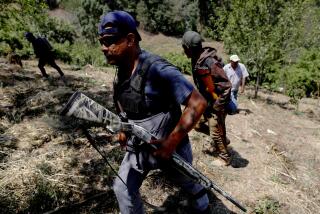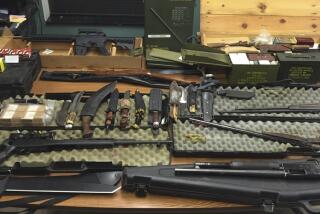Arms-smuggling report criticized as incomplete
WASHINGTON — A government audit of U.S. efforts to stop arms trafficking to Mexico was criticized Friday by a Republican lawmaker who said its conclusion that smuggled weapons from America were fueling the rise of violent Mexican drug cartels was based on incomplete data.
The report, released Thursday by the Government Accountability Office, said that the United States lacked a coordinated strategy to stem the flow of smuggled weapons.
It listed a wide array of shortcomings, both operational and legal, that it said had allowed thousands of weapons made or sold in the United States to find their way to the cartels.
One of its findings was that more than 90% of the firearms traced by authorities after being seized in Mexico over the last three years came from the United States.
At a hearing held Friday to discuss the report, Rep. Connie Mack (R-Fla.) praised its primary author for undertaking such a comprehensive and timely analysis.
But Mack said he was also “troubled by the fact that the report makes conclusions based on opinions and assumptions rather than facts.”
“I don’t know that the report itself is something that we should put a lot of value in,” Mack said.
Mack noted that out of the 30,000 firearms seized in Mexico in fiscal 2008, the report says only 7,200 were submitted for tracing.
“Where did the other 22,000 guns that were seized come from? Venezuela? Europe? Ecuador? Nicaragua?” Mack asked, adding that the incomplete sample undermined some of the report’s broader conclusions.
The report acknowledges that its findings are based on a percentage of the seized guns.
But lead author Jess T. Ford, the GAO’s director of international affairs and trade, told the committee that he stood by the conclusions.
In prepared testimony summarizing the report, Ford said that “available evidence indicates a large percentage of the firearms fueling Mexican drug violence originated in the United States, including a growing number of increasingly lethal weapons.”
The report cites U.S. law enforcement officials as saying that their “experience and observations corroborated that most of the firearms in Mexico had originated in the United States.”
Ford said Mexico must provide more resources and training to its officers so they can submit more guns for tracing.
In an interview, Mack said he was concerned that the report’s findings were being politicized by advocates of more restrictive laws on gun purchases, and he noted that the report itself makes such recommendations.
He said tighter controls on U.S. gun purchases were not the answer, and that the best way to stop the flow of firearms from the U.S. into Mexico would be to station more federal agents at the border to check for them.
Ford, under questioning during the hearing, agreed that the U.S. government needed to do a better job of inspecting southbound traffic for illegal weapons.
But “regardless of whether we know where 100% of the guns came from, I think we should be concerned that 20,000 of those guns” over a five-year period came from the U.S., Ford said, citing data from the report.
--
More to Read
Sign up for Essential California
The most important California stories and recommendations in your inbox every morning.
You may occasionally receive promotional content from the Los Angeles Times.










